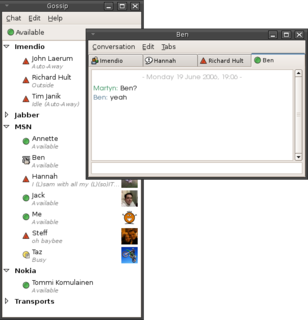Related Research Articles

The Internet is the global system of interconnected computer networks that uses the Internet protocol suite (TCP/IP) to communicate between networks and devices. It is a network of networks that consists of private, public, academic, business, and government networks of local to global scope, linked by a broad array of electronic, wireless, and optical networking technologies. The Internet carries a vast range of information resources and services, such as the inter-linked hypertext documents and applications of the World Wide Web (WWW), electronic mail, telephony, and file sharing.

Mass media refers to a diverse array of media technologies that reach a large audience via mass communication. The technologies through which this communication takes place include a variety of outlets.
In computer technology and telecommunications, online indicates a state of connectivity and offline indicates a disconnected state. In modern terminology, this usually refers to an Internet connection, but could refer to any piece of equipment or functional unit that is connected to a larger system. Being online means that the equipment or subsystem is connected, or that it is ready for use.

Online chat may refer to any kind of communication over the Internet that offers a real-time transmission of text messages from sender to receiver. Chat messages are generally short in order to enable other participants to respond quickly. Thereby, a feeling similar to a spoken conversation is created, which distinguishes chatting from other text-based online communication forms such as Internet forums and email. Online chat may address point-to-point communications as well as multicast communications from one sender to many receivers and voice and video chat, or may be a feature of a web conferencing service.
Technological convergence, also known as digital convergence, is the tendency for technologies that were originally unrelated to become more closely integrated and even unified as they develop and advance. For example, watches, telephones, television, computers, and social media platforms began as separate and mostly unrelated technologies, but have converged in many ways into interrelated parts of a telecommunication and media industry, sharing common elements of digital electronics and software.
New media are forms of media that are computational and rely on computers and the Internet for redistribution. Some examples of new media are computer animations, video games, human-computer interfaces, interactive computer installations, websites, and virtual worlds.

A mobile device is a computer small enough to hold and operate in the hand. Handheld computer devices will typically have a LCD or OLED flat screen interface, providing a touchscreen interface with digital buttons and keyboard or physical buttons along with a physical keyboard. Many such devices can connect to the Internet and connect with other devices such as car entertainment systems or headsets via Wi-Fi, Bluetooth, cellular networks or near field communication (NFC). Integrated cameras, the ability to place and receive voice and video telephone calls, video games, and Global Positioning System (GPS) capabilities are common. Power is typically provided by a lithium-ion battery. Mobile devices may run mobile operating systems that allow third-party applications to be installed and run.
Educational technology is the combined use of computer hardware, software, and educational theory and practice to facilitate learning. When referred to with its abbreviation, edtech, it is often referring to the industry of companies that create educational technology.
Audience measurement measures how many people are in an audience, usually in relation to radio listenership and television viewership, but also in relation to newspaper and magazine readership and, increasingly, web traffic on websites. Sometimes, the term is used as pertaining to practices which help broadcasters and advertisers determine who is listening rather than just how many people are listening. In some parts of the world, the resulting relative numbers are referred to as audience share, while in other places the broader term market share is used. This broader meaning is also called audience research.

Everyday life, daily life or routine life comprises the ways in which people typically act, think, and feel on a daily basis. Everyday life may be described as mundane, routine, natural, habitual, or normal.
Cyberpsychology is a developing field that encompasses all psychological phenomena associated with or affected by emerging technology.
Children's culture includes children's cultural artifacts, children's media and literature, and the myths and discourses spun around the notion of childhood. Children's culture has been studied within academia in cultural studies, media studies, and literature departments. The interdisciplinary focus of childhood studies could also be considered in the paradigm of social theory concerning the study of children's culture.

In sociology, the third place refers to the social surroundings that are separate from the two usual social environments of home and the workplace. Examples of third places include churches, cafes, clubs, public libraries, bookstores or parks. In his book The Great Good Place (1989), Ray Oldenburg argues that third places are important for civil society, democracy, civic engagement, and establishing feelings of a sense of place.
Social media are interactive technologies that facilitate the creation and sharing of information, ideas, interests, and other forms of expression through virtual communities and networks. While challenges to the definition of social media arise due to the variety of stand-alone and built-in social media services currently available, there are some common features:
- Social media are interactive Web 2.0 Internet-based applications.
- User-generated content—such as text posts or comments, digital photos or videos, and data generated through all online interactions—is the lifeblood of social media.
- Users create service-specific profiles for the website or app that are designed and maintained by the social media organization.
- Social media helps the development of online social networks by connecting a user's profile with those of other individuals or groups.
The following outline is provided as an overview of topics relating to community.

The sociology of the Internet involves the application of sociological theory and method to the Internet as a source of information and communication. The overlapping field of digital sociology focuses on understanding the use of digital media as part of everyday life, and how these various technologies contribute to patterns of human behavior, social relationships, and concepts of the self. Sociologists are concerned with the social implications of the technology; new social networks, virtual communities and ways of interaction that have arisen, as well as issues related to cyber crime.
Media consumption or media diet is the sum of information and entertainment media taken in by an individual or group. It includes activities such as interacting with new media, reading books and magazines, watching television and film, and listening to radio. An active media consumer must have the capacity for skepticism, judgement, free thinking, questioning, and understanding.

Screen time is the amount of time spent using a device with a screen such as a smartphone, computer, television, or video game console. The concept is under significant research with related concepts in digital media use and mental health. Screen time is correlated with mental and physical harm in child development. The positive or negative health effects of screen time are influenced by levels and content of exposure. To prevent harmful exposure to screen time, some governments have placed regulations on its usage.

Problematic smartphone use is proposed by some researchers to be a form of psychological or behavioral dependence on cell phones, closely related to other forms of digital media overuse such as social media addiction or internet addiction disorder. Other researchers have stated that terminology relating to behavioral addictions in regards to smartphone use can cause additional problems both in research and stigmatization of users, suggesting the term to evolve to problematic smartphone use. Problematic use can include preoccupation with mobile communication, excessive money or time spent on mobile phones, and use of mobile phones in socially or physically inappropriate situations such as driving an automobile. Increased use can also lead to adverse effects on relationships, mental or physical health, and ensues anxiety if separated from a mobile phone or sufficient signal. Preschool children and young adults are at highest risk for problematic smartphone use.
The relationships between digital media use and mental health have been investigated by various researchers—predominantly psychologists, sociologists, anthropologists, and medical experts—especially since the mid-1990s, after the growth of the World Wide Web. A significant body of research has explored "overuse" phenomena, commonly known as "digital addictions", or "digital dependencies". These phenomena manifest differently in many societies and cultures. Some experts have investigated the benefits of moderate digital media use in various domains, including in mental health, and the treatment of mental health problems with novel technological solutions.
References
- Paul DiMaggio, Eszter Hargittai1, W. Russell Neuman, and John P. Robinnson, Social Implications of the Internet, Annual Review of Sociology, Vol. 27: 307-336 (Volume publication date August 2001), doi : 10.1146/annurev.soc.27.1.307
- Waipeng Lee and Eddie C. Y. Kuo, Internet and Displacement Effect: Children's Media Use and Activities in Singapore , JCMC 7 (2) January 2002